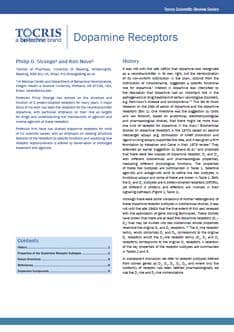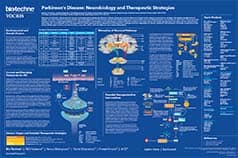Trace Amine 1 Receptor
The trace amine 1 (TA1) receptor (also known as the trace amine-associated receptor 1, TAAR1) is a class A GPCR that is activated by endogenous trace amines. To date, the TA1 receptor is the only trace amine-associated receptor that has been de-orphaned.
Trace Amine 1 Receptor Agonists |
|
|---|---|
| Cat. No. | Product Name / Activity |
| 3548 | Dopamine hydrochloride |
| Endogenous agonist at trace amine 1 (TA1) receptor and dopamine D1-5 receptors | |
| 6833 | RO 5263397 hydrochloride |
| Potent TA1 receptor agonist | |
Trace Amine 1 Receptor Antagonists |
|
| Cat. No. | Product Name / Activity |
| 4518 | EPPTB |
| Trace amine 1 (TA1) receptor antagonist; also displays inverse agonism | |
The trace amine 1 (TA1) receptor (also known as the trace amine-associated receptor 1, TAAR1) is a class A GPCR that is activated by endogenous trace amines such as β-phenylethylamine, tyramine and octopamine. Trace amines differ from classic biogenic amines, such as serotonin and histamine, in that they are present only at trace levels due to rapid hydrolysis by monoamine oxidase. The role of trace amines in vertebrates is not yet fully understood, but neuromodulatory functions have been proposed.
The TA1 receptor belongs to a family of GPCRs known as the trace amine-associated receptors (TAARs), with the gene TAAR1 encoding the TA1 receptor. While members of this family show homology to aminergic receptors, they do not all exhibit high affinity for trace amines; thus far, only the TA1 receptor has been de-orphaned. It is predicted that there are five other functional TAAR genes in humans and a further nine genes in mice and rats.
TA1 receptors are widely distributed throughout the human central nervous system, with low levels of expression in the amygdala and trace levels in the cerebellum, hippocampus and hypothalamus, as well as in some peripheral tissues, such as the kidneys and lungs. In mice, TA1 expression has been identified in the amygdala and in monoaminergic nuclei, such as the dorsal raphe nucleus. TA1 receptors have been implicated in the etiology of depression, Parkinson's disease, schizophrenia and attention-deficit hyperactivity disorder.
External sources of pharmacological information for Trace Amine 1 Receptor :
Literature for Trace Amine 1 Receptor
Tocris offers the following scientific literature for Trace Amine 1 Receptor to showcase our products. We invite you to request* your copy today!
*Please note that Tocris will only send literature to established scientific business / institute addresses.
Dopamine Receptors Scientific Review
Written by Phillip Strange and revised by Kim Neve in 2013, this review summarizes the history of the dopamine receptors and provides an overview of individual receptor subtype properties, their distribution and identifies ligands which act at each receptor subtype. Compounds available from Tocris are listed.
Parkinson's Disease Poster
Parkinson's disease (PD) causes chronic disability and is the second most common neurodegenerative condition. This poster outlines the neurobiology of the disease, as well as highlighting current therapeutic treatments for symptomatic PD, and emerging therapeutic strategies to delay PD onset and progression.

